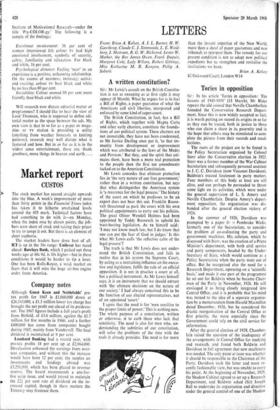The good fight
ADVERTISING ROGER PEMBERTON
'If you've still got some fight left in you, fight with the Express.' Thus the latest advertising campaign from Fleet Street. Lord Beaverbrook was nothing if not a fighter and this campaign can be said to be faithful to Express tradition. But did his choice of battles contribute to the paper's success? Mr Cecil King has contrasted the Mirror's undoubted influence on the politi- cal behaviour of its readers with the ineffective- ness of the Daily Express. Unlike Lord Beaver- brook, Mr King, it appears, has always made sure he is on good ground before opening fire.
Lord Beaverbrook's battles may well have helped to.sell the paper even if readers did not feel involved in them. But the interesting ques- tion is now posed : is this new campaign a nostalgic cri de coeur, setting the Express apart from its competitors, who by implication are following opinion rather than leading it? Or has the Express learned from research (in this case 'concept' or 'copy' testing) that this is the most telling advertising appeal for the new readers it is chasing? These questions lead naturally on to others that must face the in- creasingly competitive world of publishing. Will newspapers (and ITN/ companies) come to concentrate on topics suggested by market re- search rather than by the editor's hunch? And finally—the question that also faces the political parties when they use market research—will their stance be governed or at least influenced by the attitudes revealed in surveys, the logical conclusion of which might be 'journalism by Garnett'?
A number of newspapers use research to find out how readers regard particular features in their own and competitors' columns. But the history of the Sun suggests that journalists, like politicians, are not easily encroached on by market research. A massive piece of published research concerning the attitudes and aspira- tions of the rising generation led to a starry- eyed advertising campaign of Wilsonian (1964 vintage) grandeur. When, after weeks of adver- tising, the first number of the Sun flopped off the press, it was seen to be little more than the old Daily Herald with a yellow blob on it—a classic case of the product failing to live up to the advertising.
Paradoxically, although publishing is unlikely ever to be governed by market research, news- papers and magazines probably use research more widely than any other product or service. For besides its value in improving the position of the product vis-a-vis competitors, the justifica- tion of advertising rates in a magazine or news- paper depends on a properly documented picture of the readership and the extent • to which it is in 'some sense exclusive. A cor- responding situation exists with ITV, but with a different emphasis: the programme companies are governed to a large extent by the audience they must 'deliver' to adver- tisers, ascertained' through through research: but in addition they must woo national as well as local advertisers to buy advertising time in their area. To this end, research is used to demonstrate the value of their area for test marketing purposes, or as the basis of a joint experiment between TV company and ad- vertiser. (This is also done to some extent by newspapers—and particularly by regional ones.) Moreover, the introduction of colour TV iS producing a flood of research on the 'pull- ing' power of colour: a recent IPA paper (IPA Occasional Paper No. 18: January 1966) quoted an American study—from Dr Dichter's Institute of Motivational Research—under the title `Psy-COLOR-gy.' The following is a sample of the findings: Emotional involvement: 36 per cent of women interviewed felt colour TV had high emotional involvement, symbolic of security, safety, familiarity and relaxation. For black and white, 16 per cent.
Psychological distance: Feeling 'near' to an experience is a positive, welcoming relationship. On the counts of nearness; intimacy; active; and exciting; colour Tv beat black and white by no less than 80 per cent.
Sociability: Colour seemed 60 per cent more friendly than black and white.
Will research ever dictate editorial matter or programmes? I should like to hear the view of Lord Thomson, who is supposed to define edi- torial matter as the space between the ads. My own view is that in so far as a paper or maga- zine. or TV station is providing a utility (anything from weather forecasts to knitting patterns), research may well dictate what is featured and how. But in so far as it is in the widest sense entertainment, there are, thank goodness, more things in heaven and earth . . .







































 Previous page
Previous page